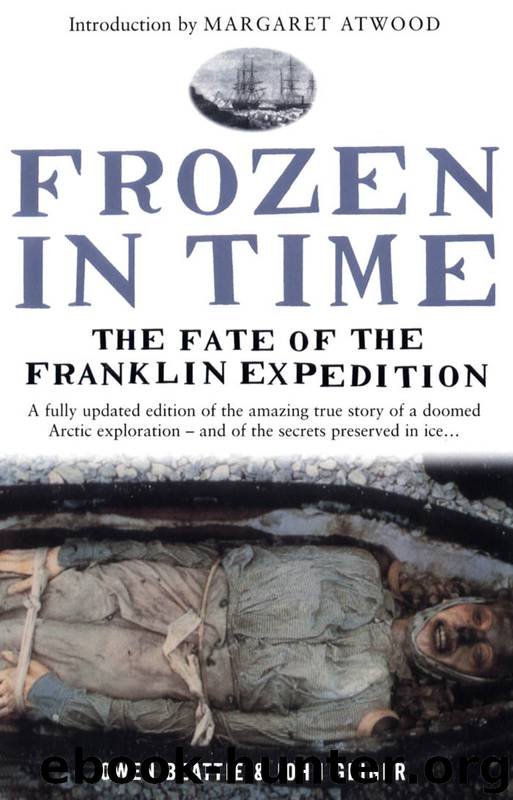Frozen in Time by John Geiger & John Geiger

Author:John Geiger & John Geiger
Language: eng
Format: epub
Publisher: Bloomsbury Publishing
Published: 2004-09-22T04:00:00+00:00
Cherrywood pipe.
While systematically searching the boat place, Tungilik caught sight of a small ivory-white object projecting slightly from a mat of vegetation. Picking at the object with his finger, out popped a human talus (ankle bone). With his trowel, Carlson scraped the delicate, dark green vegetation aside, revealing a series of bones immediately recognizable as a virtually complete human foot. Continuing his excavation, which lasted into the early morning hours of 13 July, Carlson found that most of the thirteen bones from the left foot were articulated, or still in place, meaning that the foot had come to rest at this spot and had not been disturbed since 1848. The remaining skeletal remains varied from a calcaneus, or heel bone (measuring 3 inches/8 cm in length), to a tiny sesamoid bone (no bigger than .12 inches/3 mm across). Also found was part of the right foot from the same person, which supported the interpretation that a whole body once rested on the surface at this spot.
M’Clintock had argued that, as the lifeboat was found pointing directly at the next northerly point of land, it was being pulled back towards the deserted ships, possibly for more supplies:
I was astonished to find that the sledge (on which the boat was mounted) was directed to the N.E … A little reflection led me to satisfy my own mind at least that this boat was returning to the ships. In no other way can I account for two men having been left in her, than by supposing the party were unable to drag the boat further, and that these two men, not being able to keep pace with their shipmates, were therefore left by them supplied with such provisions as could be spared, to last them until the return of the others with fresh stock.
The 1982 discoveries at the boat place supported this interpretation: the human skeletal remains were found scattered in the immediate vicinity of the lifeboat, and in the direction of the ships for a distance of two-thirds of a mile. It appears that those pulling the lifeboat could go no further and had abandoned their burden and the two sickest men. They continued on, but some had nevertheless died soon after.
In all, the remains of between six and fourteen individuals were located in the area of the boat place. In determining the minimum number of individuals from the collection of bones, Beattie first looked to see how many of the bones were duplicated. Then he examined their anatomy, such as size and muscle attachment markings, comparing bones from the left and right sides of the body to see if they were from one or more individuals.
Beattie was sure that the bones had been missed by Schwatka. From his journal, it is obvious that Schwatka was reasonably thorough in his collection of bones. He had discovered the skull and long bones of at least four individuals and buried these at the site. As in the previous searches along the coast that summer, Beattie and his crew were not able to find this grave.
Download
This site does not store any files on its server. We only index and link to content provided by other sites. Please contact the content providers to delete copyright contents if any and email us, we'll remove relevant links or contents immediately.
| Africa | Americas |
| Arctic & Antarctica | Asia |
| Australia & Oceania | Europe |
| Middle East | Russia |
| United States | World |
| Ancient Civilizations | Military |
| Historical Study & Educational Resources |
Cecilia; Or, Memoirs of an Heiress — Volume 1 by Fanny Burney(31350)
Cecilia; Or, Memoirs of an Heiress — Volume 3 by Fanny Burney(30947)
Cecilia; Or, Memoirs of an Heiress — Volume 2 by Fanny Burney(30907)
The Secret History by Donna Tartt(16657)
Sapiens: A Brief History of Humankind by Yuval Noah Harari(13073)
Leonardo da Vinci by Walter Isaacson(11917)
The Radium Girls by Kate Moore(10915)
Sapiens by Yuval Noah Harari(4551)
The Wind in My Hair by Masih Alinejad(4427)
How Democracies Die by Steven Levitsky & Daniel Ziblatt(4412)
Homo Deus: A Brief History of Tomorrow by Yuval Noah Harari(4289)
Endurance: Shackleton's Incredible Voyage by Alfred Lansing(3854)
The Silk Roads by Peter Frankopan(3779)
Man's Search for Meaning by Viktor Frankl(3647)
Millionaire: The Philanderer, Gambler, and Duelist Who Invented Modern Finance by Janet Gleeson(3575)
The Rape of Nanking by Iris Chang(3526)
Hitler in Los Angeles by Steven J. Ross(3447)
The Motorcycle Diaries by Ernesto Che Guevara(3344)
Joan of Arc by Mary Gordon(3269)
